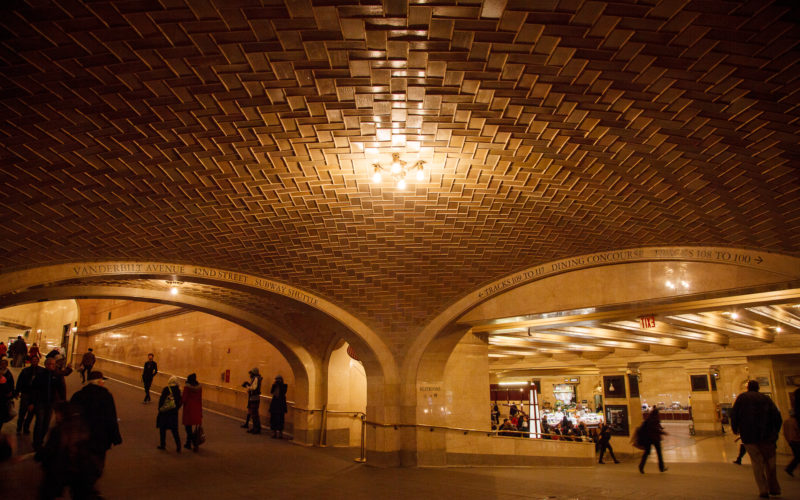

The easiest to spot are on the bottoms of the beautiful 24-carat gold-plated chandeliers, which have 110 light bulbs each! The Biltmore Room

There are carvings all over the Terminal some large, some small.

Vanderbilt was a self-made man and that symbolism resonated with him. The family motto was “Great oaks from tiny acorns grow”. That is because Cornelius Vanderbilt chose them as a family symbol. Keep an eye out all throughout the station for carvings of acorns and oak leaves. It was left as a testament to all of the different eras of history that Grand Central has seen. The missile was very big, so in order to not disturb pedestrian traffic flows, a hole was made in the ceiling so that the rocket could be suspended above the floor. The one spot was left as a reminder of how much work was done. Workers got up on the scaffolding with buckets of soap and water and paintbrushes and cleaned away the years of build-up. Over time the ceiling became coated with thick grime which was finally removed in 1998 when the terminal underwent a massive restoration spearheaded by Jackie Kenndey and other preservationists. There were a great many smokers among the nearly half-million people who passed through the terminal every day since its opening. That is just how filthy the original beautiful sky-blue ceiling had become after decades of accumulated tar and nicotine smoke. Just past that, where the blue and white meet, there is a small blackish rectangle. Look all the way over to Cancer the Crab in the northwest corner of the ceiling.
#HIDDEN BAR GRAND CENTRAL STATION MOVIE#
Some fun trivia: In the movie Madagascar, Melman the giraffe breaks the clock while the animals are in the station trying to catch a train to Connecticut. The clock helps people to not be late for their trains and prevents safety hazards with people running for trains that are about to pull out of the station. This is on purpose and is consistent with every clock inside the station. The clock is made of brass and it is said that the clock faces are made out of precious opals and that the value of the clock is well over $10 million!Īlso, if you take a look at the clock and then a quick peek at your phone or watch, you will notice that the time on the Grand Central clock is a minute or so ahead. The clock has been a long-standing meeting spot for New Yorkers. The bar is mentioned in Nell Zink's novel Doxology.The four-sided clock is possibly the most iconic feature of Grand Central.
#HIDDEN BAR GRAND CENTRAL STATION SERIES#
The Campbell Apartment was seen in the premiere episode of the television series Gossip Girl in 2007. In May 2017, the bar reopened as The Campbell. The Campbell Apartment lost its lease in June 2016 after a protracted battle with its landlord and closed its doors at the end of the following month. To avoid closing for even one night, it took place in less than 12 hours and cost $350,000. A 2006 renovation replaced a largely blue palette with a largely red one, including new carpet, bar stools and chairs. The renovation cost an estimated $1.5 million. The new bar is done in the same quatrefoil mahogany style as the balcony.

The walls and ceiling were brought back to their former glory and the original steel safe, once hidden behind a wall, now sits in the massive fireplace as a reminder of Campbell's wealth. Īfter falling into disrepair, the space was restored and renovated in 1999. It also had a small jail, in the area of the present-day bar. Īfter Campbell's death in 1957, the rug and other furnishings disappeared from his office and the space eventually became a signalman's office and later an MTA Police office, where officers stored guns and other equipment. Campbell added a piano and pipe organ, and at night turned his office into a reception hall, entertaining 50 or 60 friends who came to hear famous musicians play private recitals. The Persian carpet that took up the entire floor was said to have cost $300,000, or roughly $3.5 million today. Allen, an architect known for designing estates on Long Island and town houses in Manhattan, to build an opulent office, transforming the room into a 13th-century Florentine palace with a hand-painted plaster of paris ceiling, leaded windows, and a mahogany balcony with a quatrefoil design. At that time, it was the largest ground-floor space in Manhattan. The 3,500-square-foot (330 m 2) space was a single room 60 feet (18 m) long by 30 feet (9.1 m) wide with a 25-foot (7.6 m) ceiling and an enormous faux fireplace in which Campbell kept a steel safe. Campbell from William Kissam Vanderbilt II, whose family built the Terminal. The space was first leased in 1923 by John W.


 0 kommentar(er)
0 kommentar(er)
